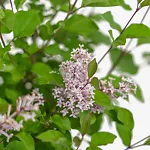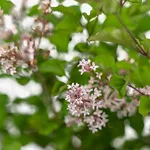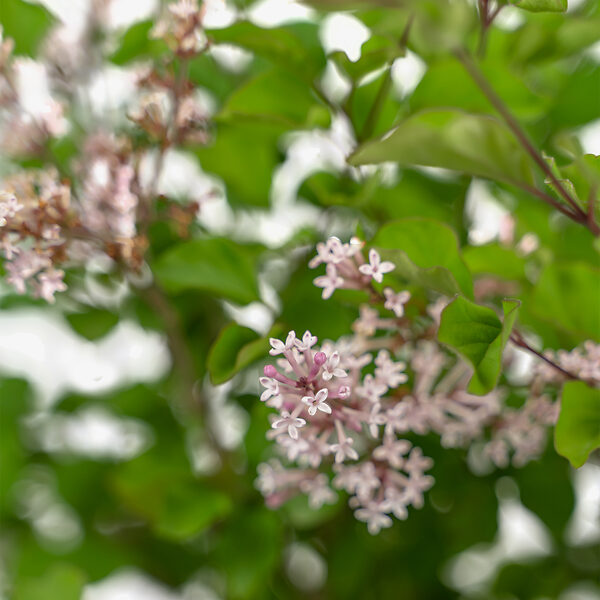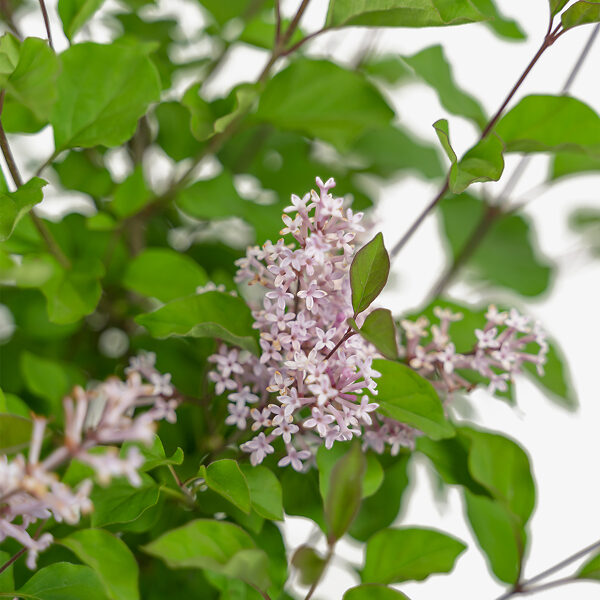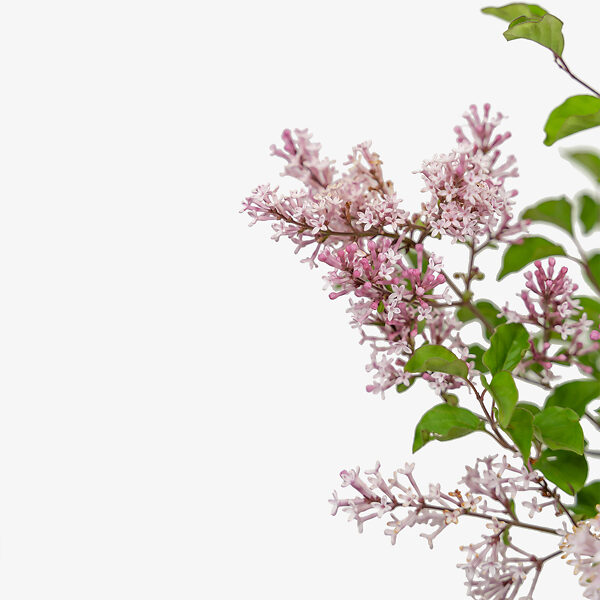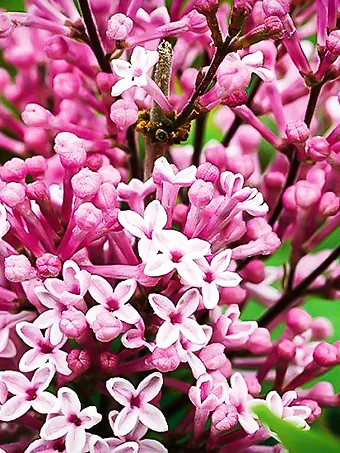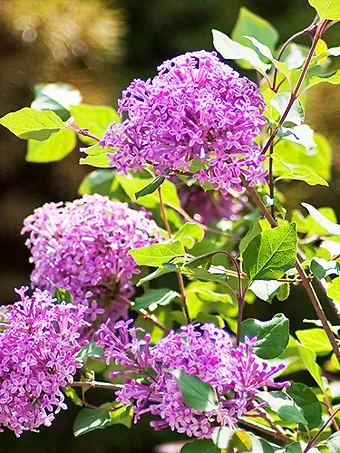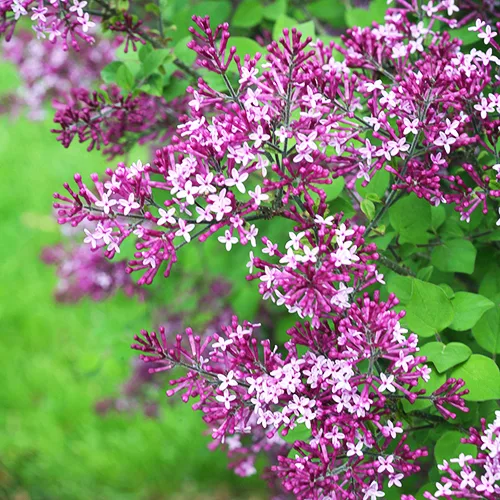
Bloomerang Dark Purple Lilac
Syringa hybrid 'SMSJBP7' (PP# 26,549)View more from Lilacs
Bloomerang Dark Purple Lilac
Syringa hybrid 'SMSJBP7' (PP# 26,549)
Select Size
30 day - ARRIVE AND THRIVE™ guaranteeLearn more


Special Features

Botanical Name
Syringa hybrid 'SMSJBP7' (PP# 26,549)
Outdoor Growing zone
3-7
Mature Height
4-6
Mature Width
4-6
Sun needs
Full Sun
The Bloomerang® Dark Purple Lilac is a superb improved reblooming lilac, with vigorous growth and abundant blooms in both spring and through the summer. It forms a rounded bush 4 to 6 feet tall and wide – perfect for beds or informal hedges. It has a dense structure and smaller leaves than traditional lilacs, but the fat flower spikes smell just as sweet, and they are the classic deep purple of the best lilacs. Then in July it is back again with a second blooming, which can continue into the fall. Perfect for small gardens where every bush must give the max, and for larger gardens too.
- Large spikes of rich purple flowers
- Blooms in spring and then from mid-summer into fall
- Full traditional lilac fragrance
- Hardy, and thrives in cooler zones
- Resistant to root diseases and ignored by deer
In full sun is the ideal spot for the Bloomerang® Dark Purple Lilac, which is hardy even in zone 3 and prefers cooler zones. It grows in ordinary well-drained garden soil, and regular watering and fertilizer after the spring bloom is the key to the most summer blooms. That little extra care will pay huge dividends in flowers that continue to the first frost. This plant is resistant to root diseases and deer don’t touch it. A light trim after the spring blooming is all the pruning it needs.
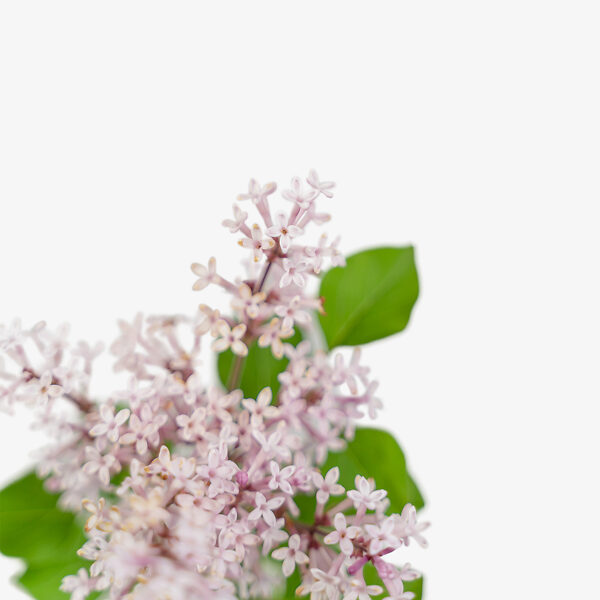
Lilac bushes are a vital part of the landscape in cooler zones, but many become large shrubs or small trees, and once they have flowered, they are not very attractive. Plant breeders got to work on this problem, and now we have lilac bushes that are more compact, with branches right to the ground. Not only do they form attractive rounded bushes that fill shrub beds well, but the best of them also re-bloom. After their spring showing blooms return over the summer, continuing to add brightness and color. They are ideal for smaller gardens, where each square foot must give as much as possible. If you love the traditional rich purples of the old lilacs, then we have just the plant – the Bloomerang® Dark Purple Lilac, with richly colored flowers that just keep on coming and coming.
The Bloomerang Dark Purple Lilac grows into a rounded shrub, with many branches, growing between 4 and 6 feet tall and wide within a few years after planting. It has a much denser branching structure than older types of lilacs, and it remains full and dense right to the ground, with only minimal pruning. The foliage is smaller too, to match the twiggy growth. Leaves are leathery but soft, with a slight sheen, and just 1½ inches long and 1-inch wide. They are more elliptical and less heart-shaped than traditional lilacs, and a medium-green color. Each branch carries a flower at the end, so both the main and side branches carry blooms, making a huge showing and smothering the bush in flowers.
The first flush of blooms appears in spring, shortly after the leaves appear. Each head of blooms carried around 120 individual blossoms, and it is 3 inches tall and wide, in a fat, conical form. The blooms are sweetly scented, and each one is a slender tube with a flared mouth and four petals opening at the end. The delicious scent of traditional lilacs surrounds you when you approach the bush, and the deep purple coloring of the blooms fills your eyes with richness – close up and from across the garden. The inside of the tiny petals is a paler purple, adding to the richness and visual texture of the beautiful heads of blossoms. That first blooming lasts 3 to 4 weeks, but unlike traditional lilacs, that is not it for the season. Your plant will take a short rest, and then in July a second crop of blooms appears – not quite as full as in spring, but still very significant. More blooming will continue right into fall until the first frost.
The Bloomerang Dark Purple Lilac really delivers color, making it ideal for smaller gardens. It can be planted as a single specimen, or mass planted in a row or a bed, spacing plants 3 or 4 feet apart. Use it as a specimen in a lawn, for lots of color, or make a lower screen along a boundary or against a fence. Plant it on the sunny side of a wooded area for an exciting transition into more natural plantings. Use it around your house among evergreens, where you can both see and smell it through the windows thrown open for spring. Everyone loves the repeat flowering of this bush, and its combination of classic lilac beauty and bushy, compact form.
The Bloomerang Dark Purple Lilac grows best in cooler zones, which is great news for northern gardeners, in both the east and the west. Hardy in zone 3, It will grow up to zone 7, if well-watered, but not in warmer zones. It should be planted in full sun for the best blooms, and in ordinary well-drained garden soil. A little care is needed to maximize reblooming, but the results are more than worth it. After the first spring blooming trim lightly to remove the spent flowers and stimulate new growth. Apply a shrub fertilizer over the root-zone, and water regularly. Drought will usually inhibit reblooming, so regular watering is valuable. It is not necessary or desirable to prune this shrub too often – that spring trim is usually all that will be needed. If you do need to prune for size or shape, do it immediately after the spring blooming. The plant has shown good resistance to the root diseases that can kill lilac bushes, and its vigorous growth helps it resist other pests and diseases. Deer don’t bother it, and it has no special needs.
There have been reblooming lilacs before, but nothing to match the Bloomerang Dark Purple Lilac. It was developed by Timothy Wood, a talented plant breeder with Spring Meadow Nursery, Inc, in Grand Haven, Michigan. He began by collecting seed from an older hybrid lilac called ‘Josee’, which has some tendency to re-bloom. ‘Josee’ has pale pink blooms and it is a three-way hybrid between Syringa pubescens, Syringa velutina and Syringa meyeri. All these lilacs come from China or Korea, and they are much more compact than the traditional European lilac. ‘Josee’ was developed around 1974 by Georges Morel for Minier Nursery in France. In 2004 Timothy Wood collected seed from that plant and grew a batch of seedlings for several years. Each year he marked the plants that rebloomed, and in the end he had three plants. Of these the best also had rich purple flowers, and it became Bloomerang®, patented in 2009 with the name `Penda’. In 2006 Wood went on to collect seed from that first plant, and again studied the seedlings. Among them was a new plant that was larger and more vigorous, producing even more blooms in the summer. It had larger blooms too, of a darker purple color. That plant is the Bloomerang® Dark Purple Lilac, patented in 2016 with the name `SMSJBP7`. Even better than the first Bloomerang Lilac, you are going to love the gorgeous color and rich blooms – so order your bushes right away, or they will be sold out when you come back.


